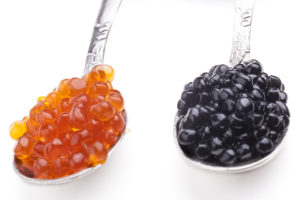Fish Roe Explained: Fish Roe vs Caviar
 The frequent interplay on the words fish roe and caviar often overshadow the unique difference between them. Thanks to the explosion of information available today, the mystique surrounding caviar has been gradually diminishing. Also, as prohibitive costs for this cuisine moderate and the consumer base gradually expands, the fish roe vs caviar question naturally comes into focus.
The frequent interplay on the words fish roe and caviar often overshadow the unique difference between them. Thanks to the explosion of information available today, the mystique surrounding caviar has been gradually diminishing. Also, as prohibitive costs for this cuisine moderate and the consumer base gradually expands, the fish roe vs caviar question naturally comes into focus.
Fish Roe vs. Caviar
Although for most, fish Roe and caviar essentially describes the same thing, there are subtle variances. The major difference between caviar and fish roe is primarily and foremost with the type of fish. However, because today’s regular caviar consumer prefers to be educated about the foods they are eating, it is important to clarify the fish roe vs. caviar argument. It is also for this reason that in most restaurants where caviar is on the menu and at caviar online resources, the type of fish where it comes from is always indicated next to the word caviar. However, if the word “caviar” is used as a standalone, especially in upscale restaurants, it is fair to assume that you are being served sturgeon eggs. Likewise; for fish roe, a prefix is always used as an indicator of the type of fish roe being used alternatively as caviar such as…
- Herring Roe (Harius) from Iceland.
- Lumpfish Roe from Iceland is frequently used to garnish appetizers.
- Salmon Roe (Ikura) with its rich orange color and recognizable pop on the tongue.
- Kelp Caviar (Seaweed) provides an alternative caviar source to fish eggs for vegetarians.
- Tobiko Flying Fish Roe is primarily used with sushi
- Trout Roe (France) also referred to as caviar for France.
- Whitefish Caviar which is the golden whitefish whose native habitat is the Great Lakes of North America.
Traditionally, only the eggs of the sturgeon fish found in the Caspian and Black sea was recognized as caviar. As such, when talking about authentic caviar, this refers specifically to the salted fish eggs of the sturgeon. Over the years however, as different species of this ancient fish are discovered in other regions of the world they too have been qualified to be processed and sold as caviar. There are approximately 27 different species in the sturgeon population. The roe of the various species used for producing caviar allow consumers to enjoy variations in size, color and flavor of these exquisite sturgeon eggs no matter which country they come from.
Terminology is another way to provide further explanation for the fish roe vs caviar question. The term “fish roe” specifically refers to the male fish sperm or eggs. Caviar on the other hand describes the end- product after the roe has been salted or cured in preparation for consumption. In Europe the term “caviar” only refers to sturgeon eggs. Also, marketing specification in Canada and the United States mandate that any product that is labeled “Caviar” alone, must refer solely to sturgeon roe.
Whether it is the highly favored roe of the sturgeon or the fish roe of urchin, shrimp, trout or salmon, these are all nutritionally rich and recognized as delicacies for the discerning palate.
Find the freshest caviar, fish roe and other specialty foods and gourmet accessories at Caviar Lover online resource. You can also learn more about caviar and find interesting tips and recipes for using caviar by visiting our Facebook page.
